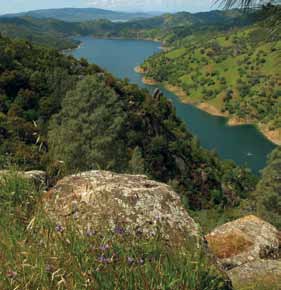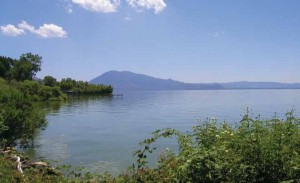By Sheila Pell

For years, scientists who study mercury have traced its path through wetlands. They’ve measured it in the water and the sediment, from algae to eagle. But they haven’t paid nearly as much attention to forests, where ominous warnings have been overlooked: A recent study by the Biodiversity Research Institute and The Nature Conservancy finds that mercury is widespread in forested ecosystems not usually considered at risk.
The pollutant hails mostly from coal burning and other industrial sources, but it’s also a natural element in the Earth’s crust and can be released by forest fires. As scientists have long known, bacteria in wetlands convert the metal to its most lethal form, methylmercury — a neurotoxin that impairs reproduction, immune function and more.
A 2002 University of Nevada study claimed, “Understanding the importance of forested systems within regional or global cycles is critical to developing a global mercury budget.”
Almost 10 years later, mercury’s reach into forests is finally coming to light.
In August 2011, the U.S. Geological Survey (USGS) released two studies concluding that fallen autumn leaves release mercury, which bacteria then convert to methylmercury. Fallen leaves and needles deliver at least as much mercury to eastern U.S. ecosystems as precipitation in the form of acid rain does. They found that mercury levels rise over the growing season and peak just before leaves change color and fall. Mercury’s lethal impacts are occurring in woodlands at the most basic level, where the food webs begin: the soil, leaves and bugs.
“For decades, researchers have missed properly characterizing the land-based food web,” says biologist Dave Evers, the principal author of the study Hidden Risk. Invertebrates, such as insects, readily absorb the toxic mercury, which then is passed up the food chain to birds and mammals, reaching “levels of great concern.”
When forests are exposed to mercury, the conversion to methylmercury takes place in the soil and leaves. Insects dine on tainted leaf litter, and then spiders eat the bugs, which results in spiders generally containing more mercury than plant-eating insects, Evers’ study reports. And the process continues: Birds pluck spiders from the trees or forage on the ground, then are consumed by other predators. As the cycle goes on, mercury levels continue to rise.

Ripple Effect
In a 2010 study, Sharon Jean-Philippe, a doctoral candidate at the University of Tennessee, investigated how trees and fungal communities adapt to soils polluted with heavy metals by examining an atomic bomb construction site in Oak Ridge, Tennessee. From 1950-1965, the creekside forest had been doused with “an acute toxic dose of mercury and other metals.” The exposure was “probably lethal to established seed banks, certain tree species, grasses, terrestrial and aquatic animals and microbial communities.”
The study focused most on the world beneath the forest, where roots interact with living soil. The availability — and ultimate toxicity — of heavy metals to plants depends on the myriad workings between soil, plants and microbes. Mycorrhizae, a group of beneficial fungi associated with most tree roots, modify the tree’s response to heavy metals.
According to Jean-Philippe’s study, “Mycorrhizae have been shown to increase heavy-metal tolerance in the host plant.” She found that some tree types fared better: “Though evidence suggests that mercury-contaminated soils may reduce tree and fungal populations, there are tolerant species that may remain and survive following contamination.”
But the overall affect of mercury in forest soil is that of diminishing richness. More sensitive populations disappear, and soil microbial communities are weakened. The imbalance of populations can leave trees less able to defend themselves from mercury exposure or less able to absorb the right nutrients. This slow poisoning may “influence species diversity of terrestrial and aquatic plants and animals,” Jeann-Philippe wrote.
From Sea to Shining Sea
Most research on mercury’s environmental impact has focused on the Northeast, where the metal is a problem in acid rain. The 2011 USGS study found that Vermont’s deciduous forests had higher mercury loads than many states, and a 2010 EPA-funded study found the highest ecosystem pools of mercury in Maine’s coniferous forests. But the pollutant is everywhere. It drifts in from Asia, blows downwind from Midwestern power plants and spews from local sources, like in the Cascade Mountains, where scientists have found elevated levels of mercury.
Some of the Cascades’ mercury is natural, a product of geologic history. In California, however, a large amount leaches from hundreds of abandoned mercury mines, a legacy of the Gold Rush, when mercury was used to extract gold from surrounding rocks due to its ability to bind with other metals. According to researchers at the University of California, Davis, up to 10 percent of an estimated 65,000 tons of mercury mined from the Coast Range between 1850 and 1920 was lost to streams in the Coast and Sierra Mountains.
The decrepit mines threaten waterways downstream in the San Francisco Bay Area and the Sacramento Bay Delta.
According to the California State Water Board, the once-prized ore is now “the most pervasive and problematic trace metal pollutant in the aquatic environment of California.”
Severe forest fires, drought, climate change: All have the potential to worsen the problem, remobilizing mercury that exists in soil, trees and plants.
“It’s a clean-water issue,” says Bob Schneider, the senior policy director of Tuleyome, a Woodland-based environmental group that received a state grant to clean up three abandoned mines. One of the nonprofit’s goals is to prevent mercury-tainted water from reaching Lake Berryessa and Cache Creek watershed, which contributes half of the mercury in the Sacramento system.
During the project’s restoration phase, Tuleyome will use the wide range of local, native plants to restore areas that mine construction and mercury contamination left barren. Producing hardy plantings, stable soils and improved habitat will gradually blur the line between the revegetated areas and adjacent undisturbed ones.
Tuleyome’s clean-up project will benefit a slew of at-risk species, including Townsend’s big-eared bat and bald eagles, which live in forests near lakes and rivers and may consume harmful levels of mercury from eating fish, according to the USGS.
Clear Lake
The most mercury-contaminated lake in the world lies in Lake County, California, where the U.S. Bureau of Land Management (BLM) is currently cleaning up abandoned mines.
USGS ecologist Dr. Tom Suchanek has spent years studying Clear Lake, where the former Sulphur Bank mercury mine dumped 100 metric tons of mercury into the ecosystem. In 1990, the mine became a Superfund site, eligible for federal aid earmarked for cleaning up the nation’s worst environmental messes.
In his study of this “mine-dominated ecosystem,” Suchanek followed the trail of mercury from abandoned mines through sediment and water and up the lake’s food web. Inorganic mercury found in low concentrations in Clear Lake builds up in organisms and is converted to methylmercury.
Because the surrounding mountains are thick with oak-madrone, manzanita, western pine and chaparral, the area is a sanctuary for wildlife, providing essential habitat for breeding, wintering and migrating birds. The birds, however, are becoming a study in the pathways of mercury, as Clear Lake is home to many fish-eating species, like Clarks and western grebes, bald eagles and osprey. According to the California Department of Fish and Game, as a bird-of-prey that depends on trees for nesting, the osprey — a federally designated sensitive species — is “a valuable indicator of forest ecosystem health.”
Studies of birds in the area show that mercury in the lake and its inhabitants has risen and fallen over the years with flooding, invasive species and other variables. The effects on birds have also fluctuated. Ospreys have maintained increasing breeding numbers, but from 2004 to 2006, their feathers showed a spike in mercury levels, a trend also seen in grebe feathers. In 2009, another study on grebe reproduction and mercury found that tissue levels of kidney, breast muscle and brain at Clear Lake were twice those of grebes at other study sites.

Further south, on 20 acres of public land in the Dry Creek Mining District, are the mines that the BLM is remediating. At the Helen Mine, the BLM identified plants as the most impacted resource due to their location and direct contact with the toxic soil. Of the five sensitive species that may be affected by remediation, four were plants. The one mammal listed is Townsend’s big-eared bat, which is known to stake claims in mine tunnels and prey on insects that may have themselves eaten mercury. The species is “at moderate risk of extinction” due to its restricted range, few populations and recent widespread declines.
While Clear Lake’s massive mercury problems have long overshadowed the many small mines in the region like the Helen, “they all have local impacts,” says Suchanek. “I would expect to see hotspots” near each one. “Some of these organisms are probably being impacted.”
That doesn’t surprise Evers, who says the findings in the Hidden Risk report “are transferable to other parts of the country.” Forests everywhere might be feeling the mercury rising.
Sheila Pell writes from Hidden Valley Lake, California, and can be reached at spell07@gmail.com.

